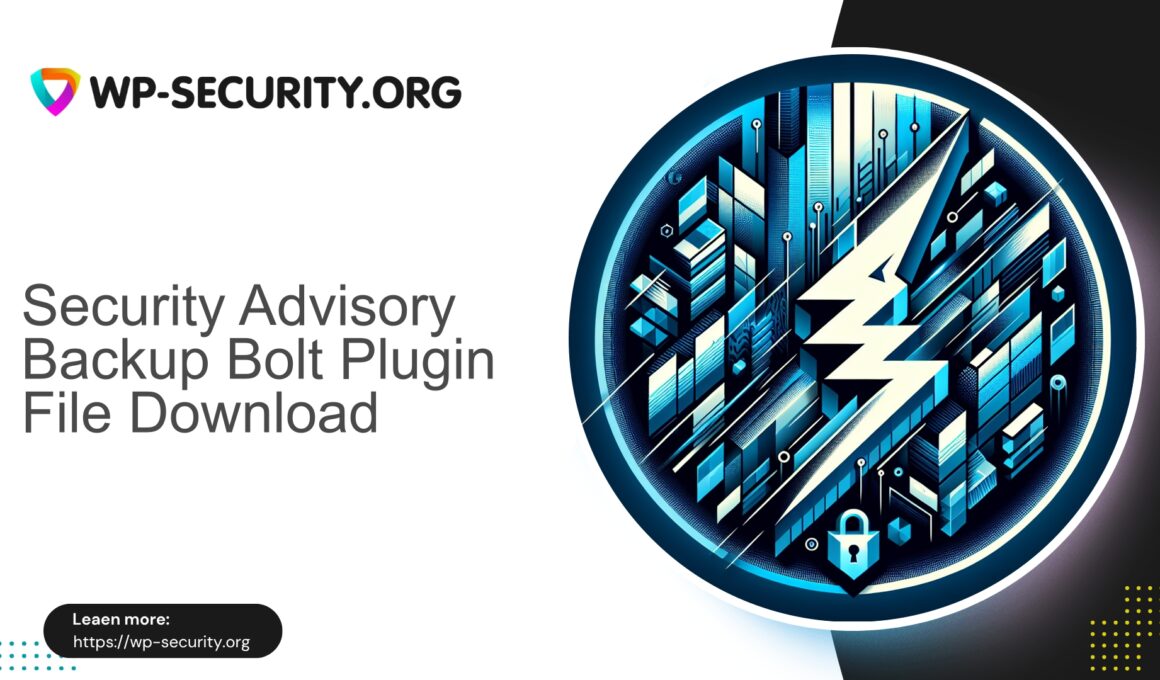| Plugin Name | Backup Bolt |
|---|---|
| Type of Vulnerability | Arbitrary File Download |
| CVE Number | CVE-2025-10306 |
| Urgency | Low |
| CVE Publish Date | 2025-10-03 |
| Source URL | CVE-2025-10306 |
Backup Bolt — Arbitrary File Download (CVE-2025-10306)
Author: Hong Kong Security Expert
Summary: CVE-2025-10306 describes an arbitrary file download vulnerability affecting the Backup Bolt WordPress plugin. The issue allows an attacker to retrieve files from the web server that should not be exposed, potentially including configuration files, backups, or other sensitive data. The vulnerability is classified as Low severity but remains relevant for organisations in Hong Kong and beyond due to potential exposure of critical data and compliance risks.
Technical overview
Arbitrary file download vulnerabilities occur when a web application provides a file retrieval mechanism that does not properly validate or restrict the requested file path. Commonly, this manifests as directory traversal (e.g. use of ../) or insufficient checks on filename parameters passed to a download handler. Successful exploitation enables an attacker to download files readable by the web server process.
What CVE-2025-10306 describes
The published record indicates Backup Bolt exposes a download mechanism that can be manipulated to return files outside the intended backup directory. Although this particular CVE is rated as Low (based on available public information), the practical risk depends on site configuration: accessible backups, exposed configuration files (wp-config.php), or other sensitive files increase the impact.
Possible exploitation vectors
- Unauthenticated HTTP requests to a plugin file-download endpoint with manipulated filename/path parameters.
- Requests embedding directory traversal sequences (e.g.
../../wp-config.php) or encoded variants. - Chaining with other misconfigurations (e.g. world-readable backup files, predictable backup filenames).
Impact
- Disclosure of site files (configuration files, backups, API keys, or database dumps).
- Information leakage facilitating further attacks (credential harvesting, lateral movement).
- Regulatory and contractual exposure if personal data is included in leaked backups.
Detection: how to check if you are affected
- Inventory: confirm the presence of the Backup Bolt plugin and its version on your WordPress installations.
- Log analysis: search webserver and application logs for suspicious requests to plugin endpoints, particularly parameters containing
..,%2e%2e, encoded traversal sequences, or direct requests forwp-config.php,.env, or known backup filenames. - Active test (careful): from a controlled network host, attempt benign probes against the plugin’s download endpoint using clearly non-sensitive target paths to observe response behavior. Never attempt to retrieve real sensitive files on production systems without authorisation.
- Use file-system discovery: check backup and plugin directories for files with overly permissive permissions or publicly readable backup archives.
Mitigation and hardening (practical steps)
Below are concrete steps to reduce exposure. These are vendor-agnostic best practices and do not rely on third-party WordPress security services.
Immediate actions
- If a patched plugin version is available from the maintainer, apply the update immediately.
- If no patch exists and the plugin is not essential, deactivate and remove the plugin.
- Restrict public access to known plugin endpoints using webserver rules or access controls while you assess and remediate.
Configuration and code-level safeguards
Where you maintain code or can configure the plugin handler, ensure strict path validation. Example PHP pattern to validate download paths:
<?php
$base_dir = realpath(__DIR__ . '/backups');
$requested = realpath($base_dir . '/' . basename($_GET['file'] ?? ''));
if ($requested === false || strpos($requested, $base_dir) !== 0) {
http_response_code(403);
exit('Forbidden');
}
// serve file using safe headers
header('Content-Type: application/octet-stream');
header('Content-Disposition: attachment; filename="'.basename($requested).'"');
readfile($requested);
?>Notes: use realpath(), restrict filenames (avoid accepting full paths from user input), and serve only from a designated backups directory.
Webserver-level restrictions
Block obvious traversal patterns and restrict access to plugin directories where appropriate.
Example nginx rule to deny requests containing .. in the URI:
if ($request_uri ~* "\.\.") {
return 403;
}Also configure your server to deny direct access to backup file extensions and sensitive filenames:
location ~* \.(zip|sql|tar|tar\.gz|env)$ {
deny all;
return 404;
}File permissions and storage hygiene
- Ensure backups and archives are stored outside the web root when possible.
- Set file permissions to limit read access to the webserver account only and avoid world-readable backups.
- Avoid storing sensitive credentials in backups retained under public directories.
Operational controls
- Rotate credentials (API keys, database passwords) if there is evidence of exposure.
- Review and tighten administrative access to WordPress and hosting control panels.
- Monitor logs for repeated or anomalous access to plugin endpoints and unusual download activity.
For incident responders
- Identify timeframe of potential exposure by reviewing logs for accesses to the plugin endpoints and any file transfer responses.
- Enumerate files that could have been downloaded and assess sensitivity (personal data, credentials, backups containing databases).
- Contain: remove or disable the vulnerable plugin, apply patches, and rotate compromised credentials.
- Notify stakeholders and regulators as required by local law and contractual obligations if personal data was exposed.
Disclosure timeline (public)
- 2025-10-03 — CVE-2025-10306 published.
- Current — apply immediate mitigations and follow up for patches from the plugin author or remove the plugin.
References
- CVE-2025-10306 — CVE Record
- OWASP: Insecure Direct Object References and Path Traversal — general guidance on safe file handling.
Conclusion
While CVE-2025-10306 is classified as Low, the presence of an arbitrary file download vector in a backup plugin is significant because backups frequently contain sensitive data. Organisations in Hong Kong must treat plugin-related exposures seriously — verify affected sites, remove or patch the plugin, restrict access to backup files, and follow up with credential rotations and monitoring where exposure is suspected.
Final note: Conduct tests only on systems you own or have explicit permission to assess. Unauthorised access or probing of third-party systems is illegal.
